

|
Back to |
| The Front Page |
| News & Features |

|
The National Croquet Center celebrates a new lease on life |
|
|
text and photos by Bob Alman layout by Reuben Edwards Posted December 18, 2004
|
|
A year ago - Christmastime of 2003, when the 10-acre facility had already been open for 18 months – the National Croquet Center had no future. I had moved to Palm Beach from San Francisco three years earlier at the invitation of founder Chuck Steuber “to help launch the Center”, with the title of Director of Sales, Marketing, and Development, determined to do whatever needed to be done – even in the face of unrelenting financial emergency – to make the place succeed. But from the day it opened in May of 2002 the Center was on the brink of insolvency, poorly managed if managed at all, and without money to invest in development or to hire adequate staffing. Implementing a rational business and development plan was simply not possible in those circumstances. Now all of that has changed. The Center once again has the brilliant – if not yet absolutely assured - future predicted for it five years ago as the first croquet enterprise of its kind to succeed as a business venture.
In the mainstream national media, Florida’s big news of 2004 was all about an unprecedented season of hurricanes, two of which struck Palm Beach County and the National Croquet Center in September.

|
| A few weeks after the hurricanes, this broken tree with new growth was an eloquent metaphor for the organizational recovery of the National Croquet Center from insufficient management, staffing and financing. |
But in the tiny world of croquet, 2004 may be remembered as the year the National Croquet Center was, at last - after two years of wasted opportunity – financed, staffed and organized to succeed.
Why did it take this long? It’s actually a fascinating but long story, and I have compiled extensive notes and documentation for a detailed “History of the National Croquet Center” to be published in the far future, when the atrocities of the past can be recounted dispassionately and instructively, with all the names and dates and references neatly in place. It will be a compelling case history of the kind of organizational dysfunction endemic to amateur associations of all kinds, but magnified to ludicrous extremes in a high-stakes enterprise the unaccustomed scale of which the South Florida croquet establishment was ill prepared to confront. But in the meantime, you deserve at least a synoptic overview:
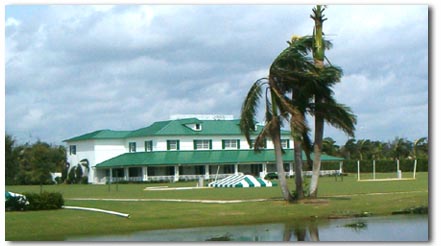
|
| The day after the first hurricane struck, the Harpo Marx Fairway was full of water, some trees were lost and others sadly stripped, and the courtside shelters were damaged, but the most important elements of the Center were in perfect condition: the clubhouse and the lawns. The second hurricane, though more violent, revealed no more vulnerabilities than the first. |
A synopsis of the decline and fall
In the fall of 2001, the visionary founder of the National Croquet Center suffered a debilitating stroke that rendered him incapable of further hands-on management. His management style had been loose, but also firm, and he could always be counted on to confront his mistakes and take responsibility for making things work. After his stroke and for the next two years, the Center was virtually unmanaged. A number of persons and committees were nominally in charge, but clearly none of them was willing or able to do what needed to be done to lay a rational foundation for the Center’s growth and survival.
All the managers and “committee members” were part-time or no-time off-site volunteers, and they tended to treat the onsite staff like clerks instead of competent professionals. So the Center was operated very much like a croquet club would be operated, by the same people who were in many cases quite experienced in running croquet clubs. There was no money for adequate marketing outreach, collateral, or staffing to give the Center the foundation for growth that it needed. There was no viable business or development plan, and the advice of the onsite, fulltime professionals was largely ignored.
Why was this situation tolerated? A willful excess of “positive thinking” is one answer. The Center was widely regarded as a “white elephant”. It had been the product of one man’s vision and one man’s financing, and the flow of additional outside donations had dried up almost entirely by the time the Center opened in May of 2002, six months after the Steuber stroke. The officers of the Croquet Foundation of America – owners of the project – preferred to take the word of the amateur “managers” that the Center was on track to succeed. A number of patently absurd projections, some of them published, were allowed to stand unchallenged, while month followed upon month with the financial situation growing steadily, inevitably, worse.
The Center in the depths of chaos
At the time I was “laid off” in June of 2003, the finances of the Center were just about as desperate as they could be. There was even a proposal to sell some of the classic three-stalk palms – the visual signature of the 10-acre facility – in order to provide operating capital for a few months. I desperately enlisted agreement that this would be incredibly damaging. “If you’re going to sell the palms, you might as well go ahead and nail a For Sale sign to the front door,” I wrote in one memo, “because nobody will put a deposit down on an event six months in advance at a place that is clearly going out of business.” The buzz was already out on the local grapevine. Corporate people at networking events around town – potential clients of the Center - began to ask me whether it was true that the Center was going out of business.
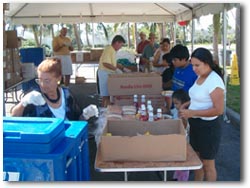
|
| From this Red Cross tent in the parking lot, volunteers served almost 100,000 meals to victims of two hurricanes, prepared by Continental Catering, the company that manages the Center's food and beverage operations. This charitable gesture resulted in some of the strongest newsprint and TV coverage the Center has enjoyed in its entire existence. |
I was thoroughly burned out and stressed out from the inherent conflicts in my job: knowing what needed to be done to have the Center succeed, but not being able to put that knowledge into action. At the same time, it was shocking to hear that the Center was now going be run somehow without professional marketing and sales management, corporate communications, media outreach, and closely managed membership development initiatives.
Despite all this, the Center’s “management committee” predicted glowing financials by the end of 2003 and breakeven by the end of the year 2004! Once again, incredibly, they were taken at their word. Many informed and intelligent observers knew these pronouncements were fantasies, but they said nothing. To say of a naked emperor that he had no clothes would be “bad PR.”
Anatomy of a Greek tragedy
How could this have happened? You’re still asking. Actually, there’s a rational explanation for why this scenario had to play out like a Greek tragedy, with all the bright observers seeing clearly that the Center was on a path to disaster. The answer is that nobody knew what to do. The situation was unprecedented in the croquet organizations, and the financial and legal status of the Center was in limbo. Technical issues of ownership and debt were very murky – to the extent that operating loans could not be secured.
So while all this was being slowly sorted out, somebody – and it turned out to be a series of somebodies – had to hold the reins of an operating entity that was clearly dying of a lack of nourishing revenue and an overabundance of expenses. If you wish, you can pronounce these somebodies to be heroes for “pitching in” when nobody else would; or you can call them villains or fools for allowing to further persist the illusion that the Center could possible succeed without competent management, staffing, and development capital. A case can be made for either viewpoint.
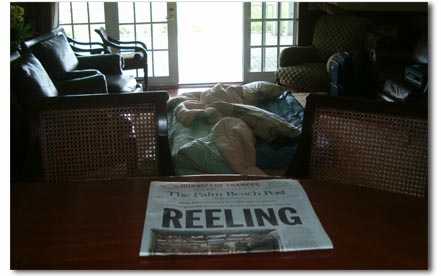
|
| The clubhouse survived the hurricanes without a scratch as expected and provided secure shelter for a dozen or more people in the local croquet establishment living in the mandatory evacuation zone, some of whom could not return home for several days. This morning-after newspaper headline on bedding put down in the Members Lounge describes the general condition of Palm Beach County, beyond the bounds of a relatively untouched Center. |
The new capitalization now meant that the Center could pay lots of bills it had stalled, and it could look for a professional on-site manager who would have the authority and the capital – not even to speak of the professional expertise and intelligence - to lay a firm foundation for the Center’s development.
Enter Jenner
That person turned out to be Mike Jenner, a youthful croquet player and Harvard MBA with ancestral roots in England who had been “retired” and traveling the American croquet circuit for a couple of years and was, in his own words, “looking for something interesting to do.” The CFA invited Jenner to come to the Center for a couple of weeks to observe the operation at the time of the Center’s second annual “Croquet the English Way” event in February of 2004. What he saw dismayed him, but at the same time he realized that in this situation he could make something happen. “And frankly,” he told me, “I didn’t know who else was going to step up to the plate and do it.”
So at last, there was somebody with professional business credentials who said, “I can do it,” and there was money available for that manager to use to develop the Center. For the Croquet Foundation of America, it looked like an irresistible hire. Perhaps a savior had come, at last.

|
| The "Executive Management Team" of the reorganized National Croquet Center is, on the whole, young, energetic, strongly motivated, and highly professional. They are: Sandy Coto, Co-director of Sales; Ron Lloyd, Executive Director of Membership; Mike Jenner, CEO; Maurya Rieder, CFO; Archie Peck, Director of Croquet; Mary Jacobs, Co-Director of Events. Not shown are Mimi Matthews and Zanaru Adamu, whose customer service jobs embrace many front-of-the-house duties, including manning the Pro Shop. |
In the eight months since Mike Jenner moved to Florida with his wife and small child (and now they have a second child), the accounting has been cleaned up, the finances and bookkeeping put in order, the expenses trimmed, a professional staff has been hired for marketing, sales, and customer service; and a Director of Membership Services has been engaged to work exclusively on membership issues. The front office that had housed only one fulltime and one part-time employee now had desks and computers for two full-timers and three part-timers, with two more part-timers at the welcoming station in the front hall.
All of this has happened just in time for the 2004-2005 “season” in south Florida. In many ways it is the first season of a fully operational National Croquet Center. If the Center is accorded a development time-span of three years (which would be normal in the hospitality industry), taking into account the fact that much of the first two years were wasted, that means the Center could be expected to achieve financial breakeven by 2007.
Making the numbers stand up and dance
But Jenner will not pin himself down to a date for breakeven; he declines to follow in the footsteps of others who so often and so blithely published rosy financial projections with arbitrary dates attached. Instead, he points to revenues in the quarter just ended as 2 ½ times the revenues in the same period of 2003. “Don’t you think that’s incredible?” he asks, and I admit that the numbers look good, presaging a prosperous high season for the January-through-April period when event sales are at their peak.
According to Jenner, the National Croquet Center is really four businesses: “In increasing order of economic opportunity, we have a retail business; a tournament business – including both schools and tournaments; a members club; and an events business – anything from a wedding to a banquet to a birthday party to a novice croquet event on the lawns.
“The biggest short-term profit opportunity – and right now my focus is making as much money as quickly as possible – is in events.” He acknowledges the future promise of the membership sector, but sees that as a slow, steady growth over time that could reach as high as 700 in a few years and at that point provide the bulk of the revenue needed to operate the club at a five-star level of service.
Jenner won’t predict the break-even point, but he proudly tracks the income stats in the critical area – events – from December 2003 to December 2004 as the shape of things to come. “Even with the extra staffing we have to get the job done, we’re already having a smaller deficit in 2004 than in 2003 – and we haven’t even seen the main part of the season yet, January through March.” Jenner absolutely promises that the expenses-over-income deficit will continue to go down annually.

When reminded that some of the expenses have up, he concedes the point: “Here’s the good news: we are now staffed to succeed. The bad news is that being staffed to succeed costs money. So with that added cost, we have to continue to expand revenues to cover the expanded cost of sales. And the numbers so far show that we can do that.”
To mitigate the cost of staff, Jenner has hired good people, he says, for under their market value – people who can do very well in the long term but who have agreed to start out on a small salary plus commission. The staff is young, bright, and high-toned – the kind of staff that makes a good impression on any potential corporate client coming through the front door.
Peanuts to save a white elephant
Working for “peanuts”, Jenner has put in consistently long hours since his term here started almost eight months ago. And his wife, while taking care of two small children, puts in lots of unpaid time as well, serving as the Chief Financial Officer and overseer of the retail operation and front-of-the-house staff…and as Mike Jenner’s loyal helpmate. What do they get out of it, if not riches? “If this place makes it, I’m going to be in the Hall of Fame,” he says only half-jokingly..
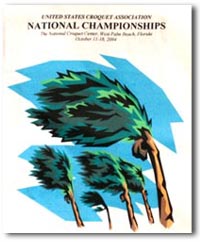
|
| The USCA National Croquet Championships in mid-October were the first major event after September's devastating storms - as suggested in the art tournament director Johnny Osborn put on his program cover. |
It will definitely be a first. Wimbledon didn’t make it as a croquet center. If the National Croquet Center makes it, Jenner will have made croquet history. He will be credited with saving and restoring to health a white elephant. If others follow the example of the Center, it could revitalize the sport worldwide. The Hall of Fame? Why not?
Giving the Center new life has required a radical shift in reality that can be described in many ways and from many different perspectives. The new leaves growing out of the splintered gray wood of a tree trunk surviving the hurricane bespeak a new future, real promise, the inevitability of growth and development. From the wreckage of the past, valuable lessons will have been learned, old mistakes need not be repeated, and management can chart a fast track to financial self-sustainability.
The Center has only one mission
What of the overall mission of the Center? "There is only one mission right now," Jenner asserts without equivocation: "That is survival. With all respect, I’m not even thinking about the growth and development of croquet overall, I can’t afford that. Sure, I can see the mission evolving after two or three years, but I’m not even thinking about that right now."
Jenner gives the impression of being always in a hurry to get to the next thing. His brisk manner seems calculated to suggest that the interview has gone on long enough. When asked what is the one thing he would like everyone to know about the state of the Center and its future at the end of 2004, Jenner responds in his typical straightforward, no-nonsense style: “We’re working as hard as we can to run the most professional operation that we can, and we’re not perfect, but we’re doing the best job that we can.” He says it with absolute conviction. Who could ask for any higher commitment than that?
What will the 2005 high season look like?
Almost everything except the physical facility is new in the National Croquet Center’s new beginning. The Center survived the hurricane season with hardly a dent; there’s little question now that the clubhouse is solidly hurricane-proof. A rebound from an unprecedented depression in the local hospitality industry will help to show that the Center’s financial health is depression-proof – especially if membership continues to grow under the watchful eye of Ron Lloyd, the Center’s Executive Director of Membership. The “Executive Management Team” is six-strong, with a varied and impressive skills set, headed by Mike Jenner as CEO. With a free hand to make his own judgments about what works and what doesn’t work, Jenner has both the smarts and the financial backing to make a most unlikely and unprecedented enterprise succeed.
The essential transformation: from amateur club to professional business
In terms that are more abstract but no less valid, the new beginning represents a radical shift from an amateur club model to a professional management model. No longer is the National Croquet Center the creature of croquet club committees with lots of “good ideas” and no ability to be responsible for their own decisions. Responsible business management demands an organized, integrated working process pointed at results and committed to rigorous self-critique - not a random collection of throw-away notions produced by committees for which no one needs to be ultimately accountable. To be fair, the latter pattern fits just about every croquet organization in the world, large and small. But it is woefully insufficient for the unique business enterprise called the National Croquet Center.
This enterprise is without precedent in America. The closest comparison is Wimbledon, which failed 130 years ago as a croquet enterprise. If the National Croquet Center survives and succeeds, that will set a precedent throughout the world and the sport. It could be a model emulated in many other places – in this country and abroad – and that could provide the spurt of growth that was the inspiration behind Steuber’s vision: Multiplying the growth of croquet in America.

A year ago, that dream was all but dead. Now the Center again has a real future. Financial breakeven will not come tomorrow or next month or even next year, but it can be predicted within several years – a prediction based, this time, on real numbers and a genuine integrated plan for marketing and development - not the fantasy projections of the past. It’s a future that rests not in the croquet community, but in the larger world where image, conventional business practice, and practical economics rule the marketplace.
Balancing image, membership privileges, and public access
It is Jenner’s intention to address every segment of that marketplace, selling the Center by competing on image, not on pricing. It’s a five-star image, with pricing to match. Yet ironically, for the first time, “the public” is invited to come to the Center to dine and to drink at the bar – and this is definitely a breakthrough. In the first two years, membership exclusivity was closely protected by the South Florida croquet elite. A proposed “Sunday Brunch and Croquet”, for example, was vetoed because it would interfere with membership privileges. Outsiders were required to pay premium rates for entry to a weekly cocktail hour event called the “Five to Nine Club” designed for younger members and potential corporate clients.
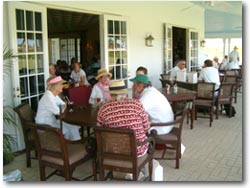
|
| The October Nationals attracted the usual number of competitors, enjoying the first "verandah weather" of the season, with the French doors of the Croquet Grille wide open at lunchtime to welcome players and members. Bookings in the 2004-05 preseason have set all sorts of records, including a corporate party for 600 people - exactly the kind of revenue bonanza needed to catapult the Center into the black. |
The offsite, amateur management never recognized a key factor in marketing a new club: It might be beautiful and special, but the building and the grounds and even the amenities – the quality of the food and drink – do not “sell” the club. What sells the club and the facility, ultimately, is a total environment – a social ambience that depends upon a certain “critical mass” of numbers. Nobody wants to go to a club or a bar that is dead and empty. There is little of value to sell in a club unless the social environment is vibrant, interesting and varied.
A fuller measure of membership exclusivity will come in time – when the numbers permit. Such is the wisdom of the marketplace – and we haven’t even talked about the economic desirability of doing enough business to pay the bartender and the restaurant staff.
The new caterer – Continental Catering – has demonstrated a high level of service and excellence, right down to finest details of candlelight, background music, and handsome table settings. Their presentation standards are fully consistently with the beauty and elegance of the clubhouse and veranda. Their long-term commitment to the success of the Center is a crucial element of Jenner’s development plan. Excellent food and beverage service, obviously, are vital to the success of a desirable social club.
As for the playing events, Jenner has determined to produce the kind of events that will nail down the Center’s reputation as croquet’s new Mecca. The events calendar does not merely mirror the traditions of American Rules croquet in the social clubs of South Florida, but reaches out into the broader croquet world to mirror the values of the sport at its highest level. America’s first “Selection Eights” event did that at the beginning of the season, and many other groundbreaking programs are planned. Other programs successfully begun are being repeated and expanded – including the English Croquet week and the Croquet Festival (going into their third editions in February of 2005).
It’s the biggest membership club bargain in South Florida
With five-star service and presentation, The National Croquet Center as a membership club is now, more than ever, the biggest membership bargain in South Florida. The only thing it lacks is a Palm Beach address – and for many, the West Palm Beach location is an advantage. Nothing remotely like it exists on this side of the Lake Worth divide between Palm Beach and West Palm Beach.
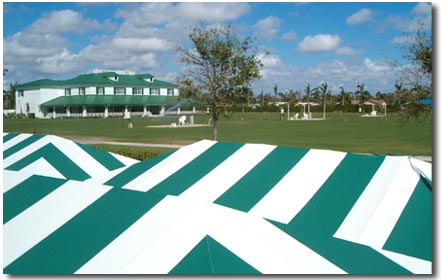
|
| Tops of the gazebos ripped away from their foundations (shown in the background) and resting in the back parking lot are the only prominent reminder of the hurricanes remaining at the end of the year. Once the cool season arrived, they were hardly missed and may not be reinstalled for months to come, in a county with a huge backlog of contracting work still to be done in both the public and private sectors. |
I saw it all from my office overlooking the lawns. After a silence of two full years on the operating state of the National Croquet Center, I am happy to report the good news to you now, without equivocation and in full confidence that the Center’s future has been restored.
For the first time, the Center has in place all the resources, the management and the staffing it needs to succeed. For the first time in two years, I can confidently predict that the National Croquet Center will succeed and even flourish. I predict that lawn tennis will never be played on any of its twelve courts. I predict that by the end of the decade, the Center’s lawns will be filled to capacity with croquet players, even in the doldrums of mid-summer.
A note on the writer: Bob Alman is the owner and manager of WicketSports Unlimited at the National Croquet Center, producing Malletball and Golf Croquet events throughout South Florida. He is the founding editor of CroquetAmerica.com and CroquetWorld.com and the editor of Malletball.com. He is also the National Marketing and Development Director of The Toequet Company, headquartered in Terre Haute, Indiana.